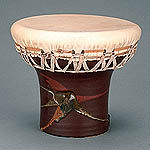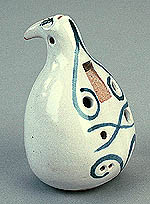
| Opus 60 - Darabukka |
|
|
The drum is often associated with dance; but, because of its strong primal rhythm, it has also been vested with magical powers and used in sacred and religious rites by several cultures. According to Tony Bloom, this instrument is a hybrid - a blend of the Arab darabukka and the Indian tabla. The stoneware pot is covered with an iron-oxide glaze.
This porcelain flute is covered with a brown glaze. The European version of the ocarina appears to have been invented in Italy around 1860, but this type of flute has existed for a very long time in South America, Asia and Africa. This instrument by Martin Breton is a variant of the globular flute.
Breton's bird-shaped instruments are in keeping with ancient traditions like that of the Aztecs, who fashioned their globular flutes in animal or human shapes. The Italian term ocarina means "little goose." A ceramist for fifteen years, Martin Breton trained extensively in Quebec and France. He has been making ceramic musical instruments since 1983. After a trip to Morocco, where he discovered the world of percussion instruments, he began making darabukkas. Around the same time, an order from a group of African musicians touring Quebec introduced Breton to udu making. Martin Breton has also crafted wind instruments, such as the ocarina, which he makes in the shape of birds and animals, and the flute. |
 |




